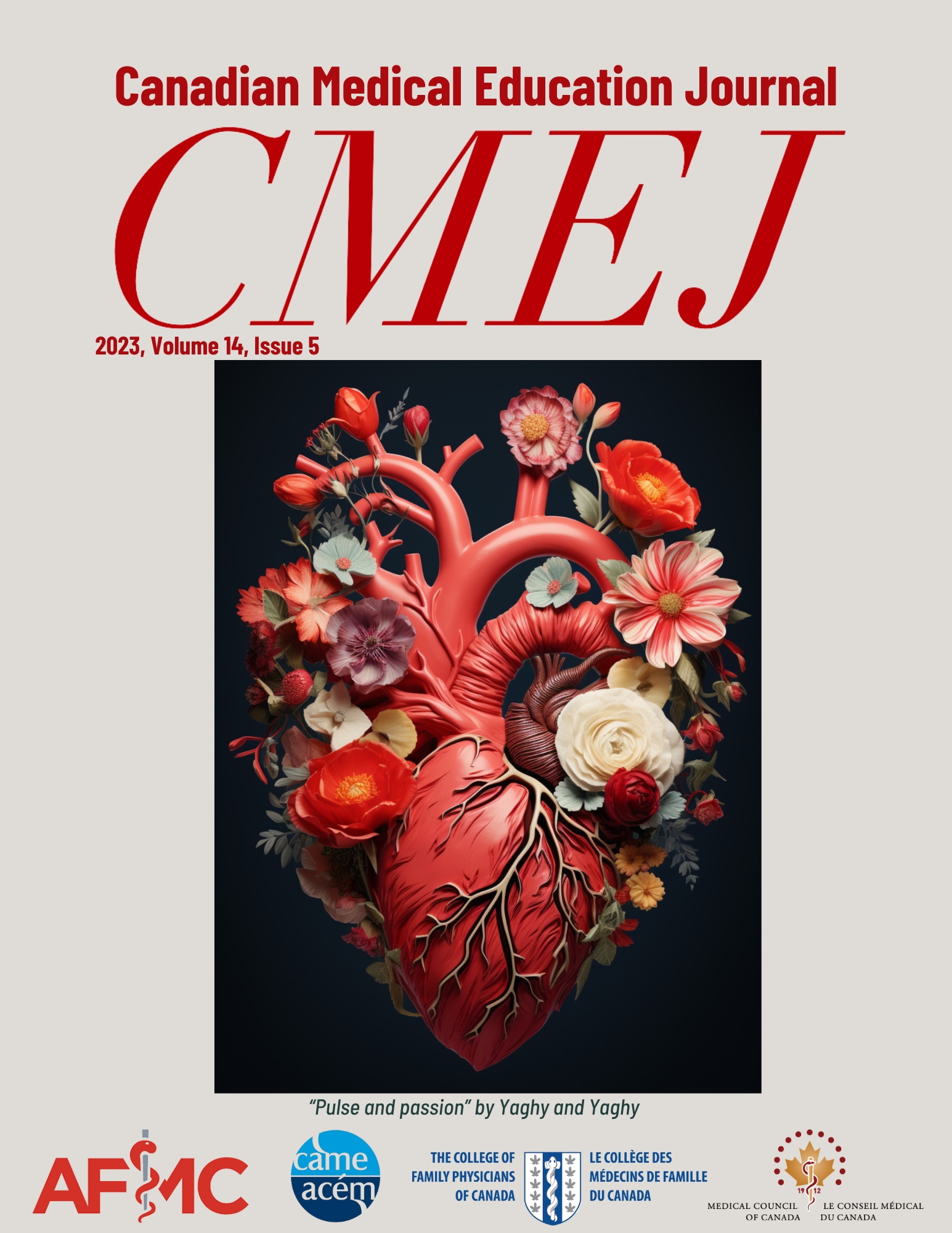The Rural Integrated Community Clerkship: a vital stretch in the Alberta rural physician workforce pipeline
DOI:
https://doi.org/10.36834/cmej.73944Abstract
Background: Longitudinal integrated clerkships are thought to operate synergistically with factors such as rural background and practice intent to determine medical graduates’ practice types and locations—sometimes known as the pipeline effect. We examined the influence of the rural integrated community clerkship (ICC) at the University of Alberta on students choosing family medicine and rural practice.
Methods: We completed a retrospective cohort analysis of graduates from 2009 - 2016. The cohort was cross-referenced by background, type of clerkship, practice type and practice location. We used χ2 analyses and risk ratios to measure the relative likelihood that ICC students would ultimately settle on rural practice and/or family medicine.
Results: ICC participation had more influence than rural background on students’ choice of rural and/or family practice, and both factors were synergistic. Rotation-based clerkship students were least likely to enter family medicine or rural practice.
Conclusions: The ICC is a clerkship model that influences students to become rural and/or family physicians, regardless of their rural/urban origins. The ICC diverts rural-interested students into rural practice and protects rural-origin students from ending up in urban practice. Expanding ICC infrastructure, including sustaining the rural physician workforce, will benefit rural Alberta communities by increasing the numbers of UA graduates in rural practice.
Downloads
References
Worley P, Couper I, Strasser R, Graves L, Cummings B-A, Woodman R, et al. A typology of longitudinal integrated clerkships. Med Educ. 2016;50(9):922–32. https://doi.org/10.1111/medu.13084 DOI: https://doi.org/10.1111/medu.13084
World Health Organization. Increasing access to health workers in remote and rural areas through improved retention: global policy recommendations. Geneva: Author; 2010.
Brooks KD, Eley DS, Zink T. Profiles of rural longitudinal integrated clerkship students: a descriptive study of six consecutive student cohorts. Med Teach. 2014;36(2):148–54. https://doi.org/3109/0142159X.2013.849799 DOI: https://doi.org/10.3109/0142159X.2013.849799
Henry JA, Edwards BJ, Crotty B. Why do medical graduates choose rural careers? Rural Remote Health. 2009;9(1):1083. https://doi.org/10.22605/RRH1083 DOI: https://doi.org/10.22605/RRH1083
Mitra G, Gowans M, Wright B, Brenneis F, Scott I. Predictors of rural family medicine practice in Canada. Can Fam Physician. 2018;64(8):588–96.
Rabinowitz HK, Diamond JJ, Markham FW, Santana AJ. The relationship between entering medical students’ backgrounds and career plans and their rural practice outcomes three decades later. Acad Med. 2012;87(4):493–7. https://doi.org/1097/ACM.0b013e3182488c06 DOI: https://doi.org/10.1097/ACM.0b013e3182488c06
Greenhill JA, Walker J, Playford D. Outcomes of Australian rural clinical schools: a decade of success building the rural medical workforce through the education and training continuum. Rural Remote Health. 2015;15(3):2991. https://doi.org/10.22605/RRH2991 DOI: https://doi.org/10.22605/RRH2991
Kwong JC, Dhalla IA, Streiner DL, Baddour RE, Waddell AE, Johnson IL. A comparison of Canadian medical students from rural and non-rural backgrounds. Can J Rural Med. 2005 Winter;10(1):36–42
Rourke J, Dewar D, Harris K, Hutten-Czapski P, Johnston M, Klassen D, et al. Strategies to increase the enrollment of students of rural origin in medical school: recommendations from the Society of Rural Physicians of Canada. Can Med Assoc J. 2005;172(1):62–5. https://doi.org/1503/cmaj.1040879 DOI: https://doi.org/10.1503/cmaj.1040879
Campbell DG, McGrail MR, O’Sullivan B, Russell DJ. Outcomes of a 1-year longitudinal integrated medical clerkship in small rural Victorian communities. Rural Remote Health. 2019;19(2):4987. https://doi.org/22605/RRH4987 DOI: https://doi.org/10.22605/RRH4987
Fuller L, Beattie J, Versace V. Graduate rural work outcomes of the first 8 years of a medical school: What can we learn about student selection and clinical school training pathways? Aust J Rural Health. 2021;29(2):181–90. https://doi.org/1111/ajr.12742 DOI: https://doi.org/10.1111/ajr.12742
Rourke J, Asghari S, Hurley O, Ravalia M, Jong M, Graham W, et al. Does rural generalist focused medical school and family medicine training make a difference? Memorial University of Newfoundland outcomes. Rural Remote Health. 2018;18(1):4426. https://doi.org/22605/RRH4426 DOI: https://doi.org/10.22605/RRH4426
Eley DS, Cloninger CR, Power DV, Brooks KD. The personalities of most medical students are suited to rural practice: Implications for rural education program recruitment. Med Teach. 2019;41(10):1160–7. https://doi.org/1080/0142159X.2019.1623388 DOI: https://doi.org/10.1080/0142159X.2019.1623388
Kwan MMS, Kondalsamy-Chennakesavan S, Ranmuthugala G, Toombs MR, Nicholson GC. The rural pipeline to longer-term rural practice: General practitioners and specialists. PLoS One. 2017;12(7):e0180394. https://doi.org/1371/journal.pone.0180394 DOI: https://doi.org/10.1371/journal.pone.0180394
Eley DS, Brooks KD, Zink T, Cloninger CR. Personality profiles of rural longitudinal integrated clerkship students who choose family medicine. Fam Med. 2015;47(3):194–203.
Downloads
Published
How to Cite
Issue
Section
License
Copyright (c) 2023 Darren Nichols, James Cockell, Daniel Lemoine, Jill Konkin

This work is licensed under a Creative Commons Attribution-NonCommercial-NoDerivatives 4.0 International License.
Submission of an original manuscript to the Canadian Medical Education Journal will be taken to mean that it represents original work not previously published, that it is not being considered elsewhere for publication. If accepted for publication, it will be published online and it will not be published elsewhere in the same form, for commercial purposes, in any language, without the consent of the publisher.
Authors who publish in the Canadian Medical Education Journal agree to release their articles under the Creative Commons Attribution-Noncommercial-No Derivative Works 4.0 Canada Licence. This licence allows anyone to copy and distribute the article for non-commercial purposes provided that appropriate attribution is given. For details of the rights an author grants users of their work, please see the licence summary and the full licence.











